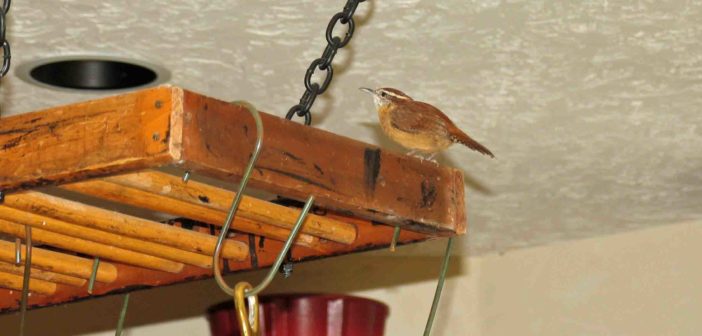Jump down to: Bird • Squirrel • Bat • Raccoon • Opossum • Mice • Snake • In chimney • Insects, spiders
Curiosity or accident can lead wildlife into a house through an open door, unscreened window, uncapped chimney or roof vent, or even a tiny hole. Except for mice and a few insects, a wild animal doesn’t enter intending to stay. It got in, wants out, and doesn’t know how. In most instances, humane wildlife removal and release doesn’t require a professional. Here’s how to humanely remove wildlife from people spaces.
Bird in a room
There’s no need to chase a bird around a room. If possible, it will automatically go to the brightest area, so attract it to windows by turning off lights. Close all doors. Open one or more windows; close curtains or blinds on unopened ones to darken them. Don’t forget to remove window screens! If necessary, shine a bright light just outside the window. Left alone for a while, the bird should go on its own.
If you must corner it, then gently cup both hands around it. It will frantically flap its wings, trying to get away, so carefully flatten them against its body to keep it from harming itself. If you can catch it with a butterfly net, all the better, but take care in removing the bird from it.
Squirrel in a room
A squirrel might walk in through an open door or window or fall down your chimney. It will frantically try to get out and can do much damage by scratching and gnawing window trim. You’ll want it out as quickly as possible but take go slow so it’ll stay calmer.
There are four ways to approach this situation.
- Remove your pets and close the interior doors to the room. Open windows and exterior doors. Cover windows that must stay closed to darken the room as much as possible. That should help draw the squirrel to the light outside. Leave it alone and keep the household quiet. It may take thirty minutes to come out of hiding—it’s frightened.
- If it’s cornered, hold a blanket up before you to disguise your human form. Approach slowly, throw it over the squirrel, and gently roll it up. Wear thick leather gloves for this—they have razor-sharp claws and chisel-like teeth. Outside, lay the blanket on the ground and gently unroll it.
- If it’s nighttime, that presents a problem because you may have to leave it indoors. Squirrels won’t venture out after dark, so keep the lights off until dawn. Before daybreak—no later—throw open the windows and any exterior doors to the room and leave it for a couple of hours. If you sprinkle flour on the windowsill beforehand, you’ll later be able to see whether it has left or is still hiding inside. You might try putting a quantity of peanut butter outside the window as an enticement.
- A squirrel can land safely from a second-story window onto soft ground, but a hard surface will injure it. So, if coaxing it out of the window isn’t an option, set a humane animal trap in the room, baited with peanut butter.
Bat in a room
First, pause and take a deep breath. Then, enjoy the experience of seeing a bat up close and personal, something few people get to do. They aren’t aggressive—even rabid bats don’t attack.
Bats are linked to rabies, but few contract it, so the bat in your house is almost certainly not rabid. Still, if touched, it’ll bite in self-defense. So, for your safety and the bats, wear thick gloves. If it bites your skin, you must turn it over to your local Animal Control Department, where it will be euthanized and tested for rabies.
Close doors to keep it confined to one room. It might zoom all around, seeking an exit. Open all the windows. Don’t be frightened about its movements. Your every instinct will be to wave your arms and try to bat (pun intended) it away, but resist the urge; it’s simply frightened. Bats have excellent eyesight, so, contrary to myth, it won’t touch you or get tangled in your hair, even if it flies very close.
When it settles down, slowly place a jar over it and a stiff piece of paper beneath it to trap it in the jar. To release it, hold or lay the jar on its side outdoors at an aboveground level, such as a porch railing, as bats can’t take off from a flat surface (they have to “fall” into the air to gain lift for flying). It’ll walk to the rim and fly away.
Raccoon in a room
Close doors to keep it confined to one room. Open windows and leave it alone to find its way out. Don’t be surprised if it stays until nightfall, as it’s a nocturnal animal. Help it to an exit by placing a strong-smelling, enticing food just outside one of the open windows. Or, indoors, bait a humane animal trap with fish-flavored canned cat food, sardines, ripe bananas, jelly, peanut butter, or marshmallows.
Opossum in a room
Same as for a raccoon invasion. Use for bait: sardines, old meat, bacon, fish, or canned dog food.
Mice in a room
Mice can run through an open door, ride as a passenger in something carried from the outside, or enter through an opening as small as 0.25 inches (6.4 mm). They’ll leave a trail of small, oblong, black feces along a travel route they follow again and again. Place a humane trap that’s designed to catch mice along the path. Bait it with peanut butter.
Release mice into tall grasses or brush (to help shield them from hawks) at least one mile from your house, or they may find their way back (no kidding). That’s important because they’ll be wary and more challenging to catch if they get back inside a second time. Release them early in the morning so they can get the lay of the land and build a nest before nightfall.
An alternative method is to put peanuts in the bottom of a bucket that’s at least 15 inches (38 cm) deep. Set the bucket on the mouse trail and position two or three boxes of differing heights as steps up to the rim. Once a mouse has jumped in the bucket, it can’t get out. Shop for humane mouse traps
Snake in a room
It’s as unhappy as you are. Snakes don’t like confrontation and simply want to escape. This is true even with venomous ones. All snakes will bite if they feel threatened, but most are nonvenomous and don’t harm humans. If you believe the snake is venomous, however, it would be best to call a professional animal trapper. Don’t lose sight of it—it can find dozens of places around your house to hide in, on, behind, or under. Tips to keep yard safe from venomous snakes
How to catch a snake. (They’re fast, so you may need help.)
- Use a broom to guide it into a box or trashcan placed on its side. Snakes are escape artists, so secure the lid while carrying it outside.
- Grab it by its tail and drag it outside.
- Hold it by the tail and lift the front of its body with a stick.
- Throw a towel or blanket over it and quickly scoop the whole bundle into a container, then release it outdoors.
- Use a long stick with a Y-shaped end to pin it to the floor while sweeping it into a large bucket.
- Use a glue board (available at local hardware stores). Once caught, take it outdoors and soak the board with vegetable oil. In about an hour, the snake will have freed itself and slither away.
Don’t kill the snake. It’s against the law in many states, and snakes are also beneficial wildlife. Release it into some protective cover at the back of your yard, and don’t forget to seal the hole it used to enter your house.
Animal in a chimney
If the animal is making constant noise, it’s probably a trapped bird or maybe a squirrel trying to get out, so see “Bird in a room,” above, and “Squirrel in a chimney,” below.
Periodic sounds may be an opossum or raccoon using the chimney as a den site, perhaps even a mother raising her young. If you can, wait until the whole family leaves, usually in just a few weeks. (A chimney cap will prevent this from happening again. Before installing it, shine a light up the chimney to make sure it’s empty.)
If it’s necessary to drive them out, never use smoke or fire. An adult may or may not be able to escape safely, but babies certainly will not. Don’t do it during the day, as opossums and raccoons are nocturnal. At dusk, start using humane harassment: The Humane Society of the United States says to place a loud radio in the fireplace, shine a bright light up the chimney, and set a pan of cider vinegar at the base. Give a raccoon mother time to move all her kits to a new location; she’ll have to do it one baby at a time.
Bird in a chimney
If a bird is nesting and raising its young, it probably isn’t trapped. Once the nestlings have fledged, the parents will abandon the nest. So, wait for that if you can. (Clear out the nesting materials before using your fireplace!)
If the bird is trapped, do this: Close all the doors to the room, open windows, turn off lights, and open the fireplace damper. Hopefully, the bird will find its way down the chimney and exit through the window. If it doesn’t, force it down with a broom handle, long cord, or even a garden hose. Once in the room, it should be drawn to the bright, open window and fly out. If it doesn’t, after leaving it alone for a time, use a butterfly net to carefully catch it. Or, try to trap it in a corner and grab it with your hands. Be gentle; birds are very fragile, even the larger ones.
Squirrel in a chimney
Lower a knotted rope down the chimney for it to climb, and then leave until you believe it’s gone. If the rope trick doesn’t work, darken the room, close any interior doors, open windows and exterior doors, and open the damper. You might try channeling the squirrel directly to the nearest opening, like cattle through a chute, by arranging furniture to create a path for it to follow. Also, you might place a box just below the window to serve as a step-up. With luck, the squirrel will drop from the chimney, run along the “chute,” jump on the box, and scurry out the window. To prevent ashes and soot from getting on the floor or furniture, cover them with a drop cloth or towels.
Leave the room. If possible, go outdoors and, from a distance, watch the windows. It may take quite a while for the squirrel to come out because it’s frightened. If it detects your presence, it may shoot back up above the damper or, worse, behind a piece of furniture—you definitely don’t want the squirrel in your room longer than necessary, as it’ll try to chew its way out. For more information about a squirrel in a room, see above, “Squirrel in a room.”
Insects, spiders in a house
Trap it in a jar by quickly placing the jar over it and a stiff piece of paper under it to seal it inside. Then, just carry it outdoors.
If a spider is hanging down at the end of its silk line, just raise an open jar up under it. Once the spider is inside, use the lid or a stiff piece of paper to trap it.




